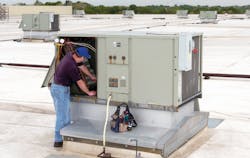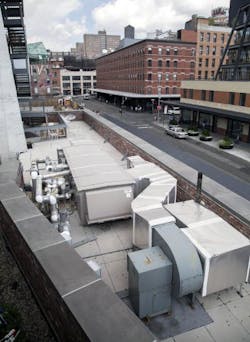Benefits of Motor Changeouts for Rooftop HVAC Equipment
Aging buildings and commercial HVAC efficiency are often not always top of mind for facility managers and building owners, but they potentially hold significant hidden energy savings. According to the U.S. Energy Information Administration, about half of all commercial buildings in the United States were constructed before 1980. In the past 37 years, motor efficiency ratings have steadily improved and drive component efficiency (belts, pulleys, etc.) has either deteriorated due to worn components or lack of proper maintenance.
Most building professionals are aware that commercial HVAC equipment is a large consumer of electricity, but they often lack the knowledge of how to target improvements that demonstrate the ability to quantify their return on investment (ROI), often called payback.
Most building professionals are aware that commercial HVAC equipment is a large consumer of electricity, but they often lack the knowledge of how to target improvements that demonstrate the ability to quantify their return on investment (ROI), often called payback. With about 26.4 percent of all commercial building energy associated with air movement, heating and cooling, efficiency improvements can have very big impacts to bottom lines.
Given the age of many commercial buildings, it should be a priority to audit installed commercial motors and determine their efficiency rating. For example, a 25 HP motor manufactured in 1980 has an efficiency rating of 88 percent. The same motor produced in 1994 has a rating of 89.3 percent. The rating increased again in 2004 to 92.4 percent. Currently, a 2017 new NEMA Premium® Efficiency rated motor has an efficiency rating of 93.6 percent. So what does this mean in real dollars? Consumers pay for kilowatt-hours (kWh), and the kilowatt savings between a 1980 motor producing 25 HP and a 2017 motor is about 5,160 kWh annually, assuming 8,000 hours of usage per year at 75 percent load. At just $0.12/kWh, the annual electricity savings is about $615.
Another target area for commercial HVAC efficiency improvement lies in the drive components attached to the motor. A typical drive consists of a motor, a motor pulley (sheave), v-belt(s) and a driven shaft attached to a fan or blower supported by bearings and fitted with a pulley. Over time, these components wear and efficiency can erode. In fact, it is not uncommon for efficiency to drop 10 percent or more due to the type of belt product used, worn components, and lack of adequate belt tension. One of the easiest efficiency improvements to make is specifying notched (sometimes called cogged) v-belts instead of wrapped style v-belts. The U.S. Department of Energy makes this recommendation and cites an efficiency gain of about 2 percent.
Once efficiency opportunities are identified, quantified upgrades can be placed within budgetary cycles and scheduled.
The easiest way for facility managers and building owners to get started on commercial HVAC energy efficiency improvement is to conduct a thorough audit of their equipment. Audits are easily conducted and offered by some motor and drive manufacturers. Some can perform pre- and post-energy usage benchmarks via monitoring equipment and generate a thorough report identifying opportunities for improvement as well as payback savings and timeline. Once efficiency opportunities are identified, quantified upgrades can be placed within budgetary cycles and scheduled.
Don Sullivan and Darryl Robertson are with Regal Beloit Corporation.

